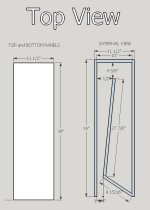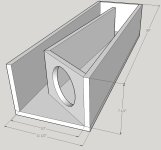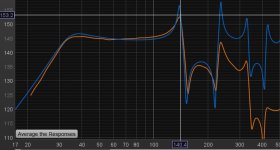Hi, i have a simple question... i have seen bass many reflex design with tilted speaker facing BR duct:

Now my question is: is not a full horn, but is still not more a reflex... depending to speaker angle.
How response change? how can i simulate it pratically ?
Someone can help me to understand this design?
Now my question is: is not a full horn, but is still not more a reflex... depending to speaker angle.
How response change? how can i simulate it pratically ?
Someone can help me to understand this design?
Is not only about duct shape or area, my question Is also about effect that woofer do facing on It.
effect that woofer do facing on It
Given it’ limited bandwidth (LF) that is mostly irrelevant. The volume lost in the box has to be accounted for.
dave
So, Dave, are you telling that this kind of load Is pretty a waste of space? Just a simple reflex could be pretty the same without wasting space?
(My example is a lot ‘longer’, so I could see what might be happening at lower frequencies in horn response )
Last edited:
are you telling that this kind of load Is pretty a waste of space?
No, I am saying that if your vent takes up more volume then the box will need to be bigger to accomodate it.
dave
It is a normal reflex, the excessive flare would hardly do anything.(My example is a lot ‘longer’, so I could see what might be happening at lower frequencies in horn response )
The driver would be 20 to 30 degrees off axis. And with a ground plane the response is flatter.
That sim shows resonance of a typical fart tube. Or a port that is too long.
looks like wrong alignment for the woofer shown, and not modeling leakage with the excessive Q in the lowend response.
Assuming the vent would be a everyday slot port, sharing 3 walls, end correction would be the usual 2.27
which would just make the needed length slightly shorter like any other slot port
Last edited:
This is just diffraction of a 12" on baffle, with a ground/floor plane added
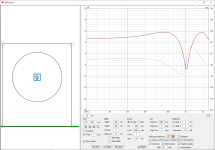
This is 40 degree Vertical tilt ( Blue) with 0 degree overlay( Orange) with ground plane.
So I correct myself 40 to 60 degree is ideal.
Just putting the driver response off axis, plain and simple.
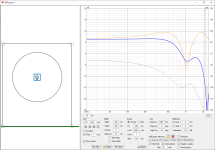
Assuming most use a basic 2nd order crossover.
This would make a dirt simple 1st order more feasible with high crossover points.
Otherwise dont do dingle.
People insist that being " 4 feet" from a side wall is some magic science.
Actually makes things worse. So again high crossover point with 1st order
helps rid sidewall barf.

This is 40 degree Vertical tilt ( Blue) with 0 degree overlay( Orange) with ground plane.
So I correct myself 40 to 60 degree is ideal.
Just putting the driver response off axis, plain and simple.

Assuming most use a basic 2nd order crossover.
This would make a dirt simple 1st order more feasible with high crossover points.
Otherwise dont do dingle.
People insist that being " 4 feet" from a side wall is some magic science.
Actually makes things worse. So again high crossover point with 1st order
helps rid sidewall barf.
Last edited:
Adding a ground plane and a sidewall at 4 feet (1200mm)
reflection is rather evident.
(Orange) 0 degree ( Blue ) 40 degree.
And showing dirt basic 12" speaker response full space ( DC300-8)
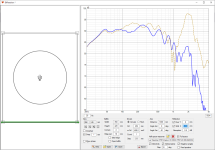
But if we look at the real world bandwidth below 300 Hz
The baffle step is flatter,
(Blue) 40 degree ( Orange Overlay) 0 degree
And you slightly gain back about 1 dB of losses to full space at the low end.
Crossover region around 250 / 300 Hz be flatter.
So pretty generic 45 degree tilt be more than fine.

reflection is rather evident.
(Orange) 0 degree ( Blue ) 40 degree.
And showing dirt basic 12" speaker response full space ( DC300-8)

But if we look at the real world bandwidth below 300 Hz
The baffle step is flatter,
(Blue) 40 degree ( Orange Overlay) 0 degree
And you slightly gain back about 1 dB of losses to full space at the low end.
Crossover region around 250 / 300 Hz be flatter.
So pretty generic 45 degree tilt be more than fine.

am I wrong or does it seem to me that building subwoofers with this "inclination" is not so effective for performance... I'm thinking of PAs, for example many 2 x 18" where the reflex is in the center and the woofer is inclined 20-30 degrees looking at itself... ok, the response does not seem much improved in the low range due to the effort of transporting a subwoofer deeper than 20-30 cm... what am I missing?
Reduced frontal area allows more drivers/boxes to fit in a given space available for subs.what am I missing?
Might add some horn gain in the midbass and mid region. Will do nothing for low frequency. Takes away a lot of volume for that nothing. Do not build 😉
Could the angle just be allowing a larger dia driver in a given dimension?
To allow both a larger driver and a front-facing vent that's large enough to sufficiently reduce power compression effects around Fb.
- Home
- Loudspeakers
- Subwoofers
- Manifold design: from tilting bass reflex speaker...
